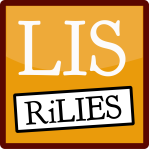 In a blog post that we published on February 2 2012 we announced that the full report of the Research in Librarianship Impact Evaluation Study (RiLIES1) was available to download, and that we would be blogging highlights of the report over the coming weeks. This is the fourth of the RiLIES1 highlights postings. Here we present lessons from five research projects that the LIS community identified as having a particularly strong impact on practitioners.
In a blog post that we published on February 2 2012 we announced that the full report of the Research in Librarianship Impact Evaluation Study (RiLIES1) was available to download, and that we would be blogging highlights of the report over the coming weeks. This is the fourth of the RiLIES1 highlights postings. Here we present lessons from five research projects that the LIS community identified as having a particularly strong impact on practitioners.
The broad aim of our first RiLIES project was to investigate the extent to which funded research projects in the domain of library and information science (LIS) influence practice in the UK. It focused particularly on identifying factors that increase or hinder the impact of research findings on those who deliver library and information services.
The projects used as case studies for understanding how to maximise impact from the perspective of researchers were: (1) Open to all; (2) eValued; (3) Researchers’ use of academic libraries; (4) Evaluating clinical librarian services; (5) School libraries in the UK. We found that they share many characteristics.
All the case study projects were initiated and planned with the explicit intention of influencing practice, and they benefited from the leadership of experienced researcher-practitioners, often in close dialogue with funding bodies throughout their duration. Where the motivation for projects explicitly includes capturing and sharing good practice, as in eValued, researchers are more likely to plan and implement activities to supports this, and this then leads to impact.
The involvement of high-profile, prestigious partners may encourage interest in a piece of work and ensure that it engages the intended audience. This helps raise the chances of a research project garnering attention and its results making an impact on practice. This is an interesting finding of RiLIES1 in that it parallels established knowledge about impact in other domains[1], yet – as far as we know – it is the first time that this has been identified in the domain of library and information science.
All the case study projects demonstrate the importance of communicating with the target audience to raise the possibility for research output to inform practice, for example by running events for practitioners, as well publishing the research results. For example, Researchers’ use of academic libraries was designed with active involvement from librarians in the HE sector, and was then overseen by a steering group of librarians.
Multiple channels of communication are also important. Face-to-face communication and training is useful for immediate impact. However, mainstream publishing is crucial for impact in the long-term: refereed journal articles and books or reports (with ISBNs) create accessible artefacts that can be used as the basis for further research and continued impact.
The case studies give good examples of how to provide for sustainability beyond the lifetime of a research project: Open to all created networks; eValued left a legacy of training materials and other resources. Project size did not emerge as a determinant for impact: Evaluating clinical librarian services shows that a small-scale project that is well explained can have strong influence.
Funding emerged in our study as key to the long-term impact of any project, particularly in cases where researchers would like to implement the recommendations of their work to date in a further study.
eValued and other projects demonstrate the benefits of creating usable artefacts (such as toolkits, training materials) and a sustainable community of practice (CoP) such as “The Network” (Open to all) to support practitioners in the implementation of research findings. However, one lesson researchers need to be aware of is that it can take a lot of work before a CoP is sustainable, and efforts need to continue beyond the funded period of the project. Projects that look to the ensuring the sustainability of their lessons will have long term impact.

The diagram illustrates how a project needs to bring together at least three elements before it can hope to achieve impact. Support from the profession and funders will be explored more extensively in our next RiLIES1 report highlights post on CPD and the role of professional bodies.
To read further details of the study please see the full RiLIES1 report, freely available to download.
References
- Walter, I., Nutley, S., & Davies, H. (2003). Research impact: A cross sector review. Literature review ESRC.



















